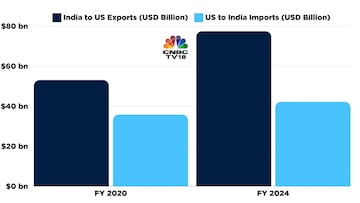
| Company | Value | Change | %Change |
|---|
“It is possible that tariffs could be leveraged in broader trade negotiations, which might touch upon (Elon) Musk’s ambitions in India,” says Divya Srinivasan, Research Associate, Centre for Social and Economic Progress (CSEP). Viewing tariffs solely as a tool to facilitate the expansion plans of billionaire chief of DOGE may be an oversimplification, she adds. However, it can’t be ruled out under Trump, whose campaign was powered and bankrolled by the CEO of Tesla and founder of SpaceX.

For instance, the Trump administration may ask for free entry and a liberalised playground for electric car makers. (AP Photo/Evan Vucci, File)
ALSO READ: The best trade of 2024 was in the making for over two years
With a possible escalation of US-China trade tensions, Tesla — which produced 469,796 cars in the July-September quarter — will want to offload its cars in other markets.
India’s likely to be one of the biggest ones to tap into. Without barriers or conditions, Tesla’s entry into India will be a challenge for homegrown electric car makers like Tata Motors, which had a 58% market share in EV sales in India as of November 2024.
ALSO READ: China’s biggest fiscal stimulus will come in 2025. Here’s why
Musk-led SpaceX may want a shot at wooing India’s 950 million plus internet users, as per the Government of India data.
However, Musk will likely face severe opposition from heavyweights like Mukesh Ambani’s Reliance Industries and Sunil Mittal’s Bharti Airtel. Local competition is not the only issue with allowing Starlink a free ride into India.
Ajay Srivastava, founder of Global Trade Research Initiative, argues that Trump may use the tariff threat to pressurise India to join the Trade Pillar of the Indo-Pacific Economic Framework (IPEF).
“The IPEF Trade Pillar advocates for the free cross-border flow of data. Trump’s administration may urge India to adopt more open data-sharing policies, which could undermine the country’s digital sovereignty,” according to Srivastava.
Any resistance from India to the requests that benefit Tesla and SpaceX is likely to be met with severe threats to areas where India relies on the US as its biggest market. For example, software exports. In the last fiscal year, the US held a 54% share of India’s $205 billion tech exports.

The BSE IT Index, comprising India’s largest IT stocks, has started cooling off from the post-US-election peak. While software exporters will benefit from the strength in the dollar, the uncertainty around Trump’s policies has started weighing on IT stocks in India.
Tata Consultancy Services, Infosys, HCLTech, and Wipro are some of the biggest players in the space and their stocks may take a hit if Trump decides to tighten H-1B visas and mandate more local in the US during his negotiation with Indian Prime Minister Narendra Modi to force India to concede to Washington D.C.’s demands.
Any protection for Indian auto or telecom majors could come at the cost of IT services or goods like gems and jewellery, auto components, solar cells and apparel. Rajesh Exports, which is India’s largest gems and jewellery exporter, will be one stock to watch, alongside Titan and Kalyan Jewellers.

India is the world’s largest exporter of diamonds.
Similarly, companies like Bharat Forge, Uno Minda and Amara Raja could lose their competitive edge if Trump decides to leverage the US demand for automobile parts with higher tariffs on exports from India. In fact, 27% of the total auto component exports worth $21.2 billion in FY24 went to the US, according to the Automotive Component Manufacturers Association of India.
Even India’s largest solar cell maker, Waaree Energies, which earns over half of its export revenue from the US, may be exposed to risks emerging beyond its own sector and from issues beyond its control.
Specific apparel categories already face tariffs of up to 32%. However, Trump may threaten to hike these rates to set the stage for deeper trade negotiations with India. Welspun, and Alok Industries will be among the stocks to watch out for in this space.
The way forward
Morgan Stanley research shows that a 10% increase in tariffs on Indian goods could decrease GDP growth by 30 basis points or so. That would amount to $10.5 billion (over ₹88,000 crore at current exchange rate) assuming India’s national income is $3.5 trillion a year.

Srivastava argues that the impact of US tariffs will largely depend on the rates imposed on specific products. Fitch Ratings believes Trump’s tariffs will affect India less than other countries. The question remains, even if it’s relatively lesser, how much of an impact can India afford to bear and what can New Delhi to avert a crisis on this count?
“A targeted reduction in tariffs could be advantageous for India, aligning with its goal of boosting low-cost, value-added manufacturing and trade,” says the GTRI founder.
CSEP’s Srinivasan believes attracting manufacturers to relocate from China to India could mitigate some of the adverse effects of US tariffs. “India must also expand its focus on strengthening trade ties with emerging and developing Asian economies, which are projected to contribute over 50% of global GDP growth in the future,” says Srinivasan. Despite this, the CSEP researcher notes that only about 20% of India’s exports go to these countries.
Lesser reliance on the US may reduce the leverage team Trump and Musk hold over India during the negotiations.



